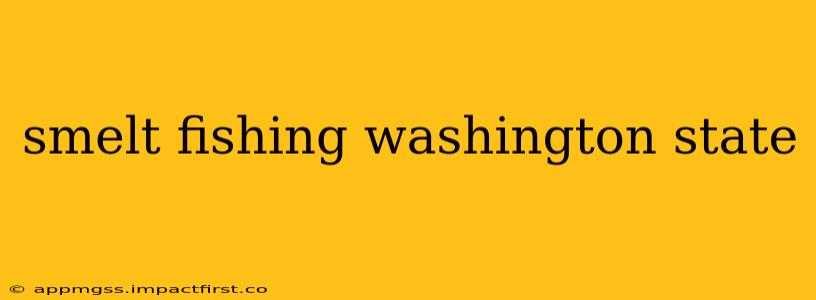Washington State's smelt runs are a treasured tradition, attracting anglers and enthusiasts alike. These small, silvery fish offer a unique and rewarding fishing experience, but understanding the regulations and techniques is crucial for a successful and responsible trip. This guide dives deep into smelt fishing in Washington, covering everything from licensing to fishing methods and conservation efforts.
What are Smelt?
Before we delve into the specifics of smelt fishing in Washington, let's understand what these fascinating fish are. Smelt are small, silvery fish belonging to the Osmeridae family. They're known for their delicate, slightly sweet flavor and are a popular food source both commercially and recreationally. Washington State is home to several smelt species, with eulachon (candlefish) and surf smelt being the most commonly targeted for recreational fishing.
Where to Smelt Fish in Washington State?
The best locations for smelt fishing in Washington vary depending on the time of year and the species you're targeting. Popular spots often include the Puget Sound area, rivers like the Snohomish and Skagit, and coastal areas. Specific locations are often kept closely guarded by experienced anglers, but local fishing reports and forums can provide valuable hints. Always check the Washington Department of Fish and Wildlife (WDFW) website for up-to-date information on open seasons and fishing areas.
What is the Best Time of Year to Smelt Fish in Washington?
The timing of smelt runs is crucial. These runs are highly dependent on water temperature and other environmental factors, and they can vary from year to year. Generally, the peak seasons for smelt fishing in Washington fall during late winter and early spring. However, precise dates can vary significantly, so staying informed via official WDFW announcements and local fishing reports is critical.
What time of day is best for smelt fishing?
While there's no single "best" time of day, many anglers find that the hours around dawn and dusk, when light levels change, are often productive. The fish may be more active during these transition periods.
What is the best gear for smelt fishing?
Smelt fishing typically utilizes lightweight gear. Small hooks, light lines, and small weights are generally used. Many anglers use dip nets, which are especially effective during the peak of a run. A sturdy net, preferably with a long handle, is essential.
What are the regulations for smelt fishing in Washington?
Regulations for smelt fishing in Washington are rigorously enforced to ensure sustainable fish populations. These regulations often include daily catch limits, gear restrictions, and seasonal closures. It's vital to consult the WDFW website or contact local authorities before your trip to fully understand the current regulations. Failure to comply can result in significant fines.
How do I get a license to smelt fish in Washington?
A valid Washington State fishing license is required for almost all smelt fishing activities. You can purchase a license online, at sporting goods stores, or at license vendors throughout the state. Always ensure your license is up-to-date and valid for the specific type of fishing you're undertaking.
What is the future of smelt fishing in Washington?
The conservation of smelt populations is a critical issue. Changes in water quality, habitat loss, and other factors can significantly impact smelt runs. The WDFW actively monitors smelt populations and implements regulations to ensure their long-term sustainability. Responsible angling practices, such as adhering to catch limits and respecting closures, are crucial in preserving this valuable resource for future generations.
This guide provides a comprehensive overview of smelt fishing in Washington State. Remember, responsible angling and compliance with regulations are crucial for the continued enjoyment of this unique fishing experience. Always check the Washington Department of Fish and Wildlife website for the most up-to-date information on regulations, seasons, and closures before you head out. Happy fishing!
